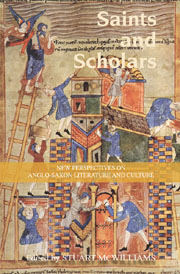 Saints and Scholars
Saints and Scholars Book contents
- Frontmatter
- Contents
- List of Contributors
- Abbreviations
- Introduction
- I Hagiography and the Homiletic Tradition
- 1 A Note on the Sensational Old English Life of St Margaret
- 2 A Place to Weep: Joseph in the Beer-Room and Anglo-Saxon Gestures of Emotion
- 3 Aldhelm's Choice of Saints for his Prose De Virginitate
- 4 Shepherding the Shepherds in the Ways of Pastoral Care: Ælfric and Cambridge University Library, MS Gg.3.28
- 5 “Consider Lazarus”: A Context for Vercelli Homily VII
- 6 More than a Female Joseph: The Sources of the Late-Fifth-Century Passio Sanctae Eugeniae
- 7 Ælfric, Leofric and In Natale Plurimorum Apostolorum
- II Aspects of Community and Consumption
- III Reflections on Old English Scholarship
- Poems
- Hugh Magennis: A Bibliography, 1981–2011
- Index
- Tabula Gratulatoria
1 - A Note on the Sensational Old English Life of St Margaret
from I - Hagiography and the Homiletic Tradition
Published online by Cambridge University Press: 05 February 2013
- Frontmatter
- Contents
- List of Contributors
- Abbreviations
- Introduction
- I Hagiography and the Homiletic Tradition
- 1 A Note on the Sensational Old English Life of St Margaret
- 2 A Place to Weep: Joseph in the Beer-Room and Anglo-Saxon Gestures of Emotion
- 3 Aldhelm's Choice of Saints for his Prose De Virginitate
- 4 Shepherding the Shepherds in the Ways of Pastoral Care: Ælfric and Cambridge University Library, MS Gg.3.28
- 5 “Consider Lazarus”: A Context for Vercelli Homily VII
- 6 More than a Female Joseph: The Sources of the Late-Fifth-Century Passio Sanctae Eugeniae
- 7 Ælfric, Leofric and In Natale Plurimorum Apostolorum
- II Aspects of Community and Consumption
- III Reflections on Old English Scholarship
- Poems
- Hugh Magennis: A Bibliography, 1981–2011
- Index
- Tabula Gratulatoria
Summary
The Life of St Margaret in Cambridge, Corpus Christi College, MS 303 is one of a number of English texts that can be dated to the post-Conquest period, attesting to the vitality of English even after the trauma of Hastings, and the cultural and political disruption caused by the process of that Conquest. The extensive hagiographic and homiletic manuscript is localised to the Benedictine cathedral of St Andrews, Rochester, and is datable to c. 1150. The manuscript is not only the product of that monastic setting, but was also probably originally intended for use within that setting itself. That use, though, as Magennis has suggested in a typically detailed and sensitive reading, was quickly extended beyond the monastic setting into the lay community, perhaps through the pastoral work of the monks, though more likely through its use as a reference tool for preachers more broadly. Indeed, sporadic glosses were made to the manuscript by contemporary users (including two of the actual scribes of the book), which indicates that there was a genuine readership for this material.
The pastoral life of the manuscript goes far beyond the twelfth century, as thirteenth- and fourteenth-century annotations and nota marks in the margins of the manuscript suggest. Particularly interesting to these readers, who seem to be carefully selecting key homiletic passages for subsequent memorisation or as the basis for extemporisation, are the seven capital sins, methods of good living, and the means of salvation.
- Type
- Chapter
- Information
- Saints and ScholarsNew Perspectives on Anglo-Saxon Literature and Culture in Honour of Hugh Magennis, pp. 5 - 13Publisher: Boydell & BrewerPrint publication year: 2012


